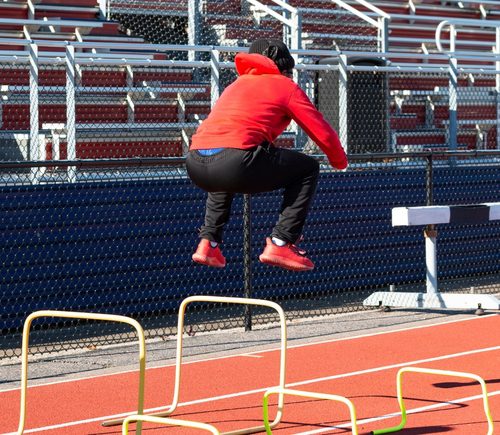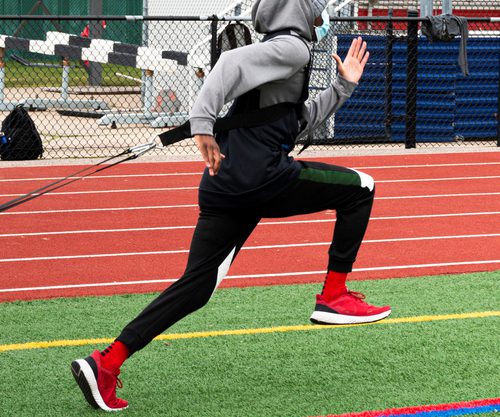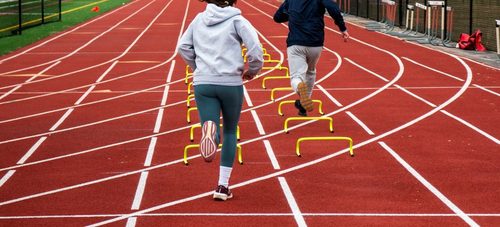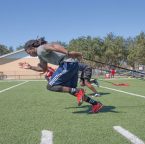Listen up, athletes! If you’re tired of being left in the dust by your competitors on the track or field, it’s time to step up your sprint game.
But hold onto your hats, because we’re about to take you on a wild ride through a vast array of exercises to improve your sprint speed. We’re not talking about your run-of-the-mill sprint intervals and plyometrics (although we’ll cover those, too).
We’re talking about explosive exercises, dynamic movements and core-strengthening techniques to give you that extra boost of power and speed.
From sprint drills to strength training moves, from agility ladders to partner exercises, we’ve got you covered with the best options for improving your sprint speed. So let’s get started!

Related: Get Freaky Fast With The Speed System From Overtime Athletes
Sprint Intervals
If you are looking to get faster then sprint intervals may be just what you need. Sprint intervals involve running at maximum effort for a short period, followed by a period of rest or low-intensity activity, also known as HIIT training.
This type of training is highly effective for improving anaerobic endurance and speed, which are crucial components for sprinting.
Sprint intervals can help improve your body’s ability to use energy more efficiently, which translates to improved performance on the track or field. By repeatedly pushing your body to its limits during sprint intervals, you’ll train your muscles to work harder and more efficiently. Additionally, this type of training can help improve your recovery time, allowing you to perform at your best for longer periods.
But wait, there’s more. This type of training can also help you burn more calories and lose fat. Sprint intervals increase your body’s metabolism, which means you’ll continue burning calories even after you’ve finished your workout.
If you want to get faster (and burn fat in the process), sprint intervals are one of the best exercises out there,

Plyometrics
If you are looking to unleash your inner Usain Bolt and leave the competition in the dust? Plyometrics are another exercises that may be just the ticket to help you increase your sprint speed!
Plyometric exercises are designed to improve explosive power and speed through rapid and powerful movements. Think jumping squats, box jumps, and other high-intensity exercises that require you to exert maximum effort in a short amount of time.

But what makes plyometrics so effective for improving sprint speeds? These exercises target the fast-twitch muscle fibers in your body, which are responsible for explosive movements like sprinting. By training these fibers to work harder and more efficiently, you’ll be able to generate more power and speed when sprinting.
Plyometrics also help to improve your body’s neuromuscular coordination, which is essential for executing quick and powerful movements. By practicing these movements, you’ll train your brain and muscles to work together more effectively, allowing you to run faster and with better form.
Plyometrics are like a secret weapon to use against other athletes that think sprint intervals are all you need.
Strength Training

Strength training is another key to faster running speeds. This doesn’t mean you have to build massive muscles like a b0dybuilder, god knows they can’t run fast, if at all.
The first and foremost benefit of strength training is that it supercharges your muscles with the power and strength necessary to generate explosive speed and acceleration. By zeroing in on your leg, hip, and core muscles, you’ll be able to churn out more force and power than ever before when sprinting.
But wait, there’s more. Strength training also works wonders in terms of enhancing your body mechanics and running form. By strengthening the muscles that support your joints and improving your posture, you’ll run more efficiently with a lower risk of injury. This translates to faster sprint times and more consistent performance on the track or field.
So what exercises should you focus on? Here is a good list of the best strength training exercises for spring speed.
- Squats
- Deadlift
- Bulgarian Split Squats
- Romanian deadlift
- Hip Thrusts
- Core Exercises
Of course, all of these are pretty much lower body exercises, although deadlifts can be considered a whole-body exercise.
Also, do not forget your core exercises. We wrote an entire article on the best core exercises for sprint speed. That article will tell you to best core exercises to focus on.
Sled Pushes and Pulls

Sled pushes, and pulls are important. In fact, we wrote an entire article about sled pulls for sprint acceleration.
When most people think about sled pulls for sprint speed, they think about a guy pulling a wimpy little sled with 10 pounds on it. That’s actually not the way to do it, though.
Research shows that heavier sled pulls are better for increasing sprint acceleration than light sled pulls. Study1 Study3.
Studies show that heavy sled pulls where you pull a sled with up to 80% of your own body weight have been shown to “increase maximal horizontal-force production compared with standard unloaded sprint training.”
While heavy sled pulls are the most beneficial, it is not recommended to completely abandon light sled pulls. Instead, a combination of light, heavy, and very heavy sled pulls should be incorporated into your training regimen, with a focus on heavier pulls. It is recommended to keep the load between 10-75% of your body weight, as anything beyond that may be excessive.
Sled pushes are also effective. This Study found that “resisted sled pushing with any load was superior to unresisted sprint training”.
Bottom line…
Sled pushes and pulls using weight up to 80% of your body weight help with sprint acceleration. It should be noted that while sled training increases acceleration, it does not increase top-end speed.
Parachute Training

Are you tired of your sprint workouts feeling stale? Want to add some excitement and intensity to your routine? Look no further than the trusty parachute!
You may have seen photos of pro athletes sprinting with a parachute behind them and wondered if it’s just for show. But let me tell you, the research doesn’t lie. In fact, a study found that using a large-sized parachute during sprint training improved velocity in the acceleration and maximum speed phases for sprinters.
Of course, like any training tool, the parachute does have its drawbacks. For instance, it may take 10-20 meters to inflate fully, leaving you with little resistance during the acceleration phase. Plus, the resistance can’t be easily adjusted like it can with a sled. And let’s not forget about the unpredictable wind, which can affect the parachute’s performance.
But don’t let those drawbacks discourage you. With proper use and consideration, the parachute can be a valuable addition to your training regimen, adding a new level of challenge and excitement to your sprints.
Hills Sprints

If you have ever done hill sprints, you know that they suck. That said, they are effective.
Hill sprints are like the turbo boost for your running game. They are high-intensity workout that engages various muscle groups in the lower body, making them a killer exercise for improving sprint speed. Let me tell you how:
Firstly, hill sprints demand more power output from your muscles due to the upward incline. This helps you develop explosive strength in your legs, which is essential for greater power and speed during sprints.
Secondly, running uphill naturally increases your stride length. Longer strides mean you cover more ground, leading to greater speed and improved running form.
Thirdly, hill sprints offer a form of resistance training that can help to develop stronger and more powerful leg muscles. This can give you a serious edge, allowing you to output greater force during sprints.
And finally, hill sprints also work wonders for your cardiovascular fitness. They require a high level of exertion and can improve your heart’s ability to pump oxygen-rich blood to your muscles, helping you sustain high-intensity workouts for longer.
Technique Training

Have you ever seen someone with running form that was so bad that it was no wonder that they couldn’t run fast?
Running faster isn’t just about putting in more effort or running harder. Sometimes it’s about training smart and focusing on techniques that can help you improve your speed. And while there are plenty of techniques to choose from, some of the most effective methods involve training your body to move in more efficient, powerful ways.
One such technique is focusing on your running form. It may seem simple, but making small adjustments to your posture, arm swing, foot strike, and cadence can help you run faster and more efficiently. By experimenting with different running styles and finding the one that works best for you, you can reduce wasted energy and run with more speed and ease.
For help with running form, you are likely going to need a coach since you really can’t see yourself running.
A coach can observe your running form, provide feedback on areas that need improvement, and develop a customized training plan to help you reach your full potential.
Or you can check out the Speed System from Overtime Athletes which gives you Acceleration Mechanics, Maximum Velocity Mechanics and much more to have you running faster than ever.
In addition to personalized guidance, a running coach can also provide accountability and motivation. By working with a coach, you’ll have someone to hold you accountable to your training plan and keep you motivated.
It’s nearly impossible to critique your own running form. So if you want to make sure you have the right form and technique to go as fast as your body will allow try using a technique coach and see what happens.
Related: Get Freaky Fast With The Speed System From Overtime Athletes
Final Word
Congratulations, my friend – you’re now armed with the knowledge to take your sprinting game to the next level! By incorporating these top exercises to increase your sprint speed into your training routine, you’ll be well on your way to building up the strength, power, and explosiveness needed to crush your goals and dominate on the track or field.
But remember, it’s not just about the exercises – fueling your body with the right nutrition, staying hydrated, and getting enough rest are also critical components of a successful training program. So, make sure to focus on all aspects of your training to ensure that you’re giving your body the care and attention it needs to perform at its best.
I won’t lie to you – training for speed isn’t easy, and it’s not for everyone. It takes time, effort, and a whole lot of sweat and tears. But if you’re willing to put in the work and stay dedicated, I promise you – the results will be worth it.

Ryan is a former college wrestler and lifelong fitness fanatic. He has run half marathons, done mud runs, placed in body transformation contests, coached wrestling, and now coaches girls’ soccer. Not to mention he has also tried literally hundreds of supplements over the years and has a vast and thorough supplement knowledge. He has written for Muscle & Strength, Testosterone Junkie, The Sport Review and other publications. He is also the editor-in-chief of this website and has over 25 years of experience in the fitness industry. Feel free to connect with him on his LinkedIn page below.









Another masterpiece